Fatigue-Induced Evolution of AISI 310S Steel Microstructure after Electron Beam Treatment
Abstract
:1. Introduction
2. Materials and Methods
3. Results and Discussion
3.1. Structure of the As-Delivered AISI 310S Steel
3.2. Fatigue Testing Results
3.3. Modeling the Temperature Field Developing in the Steel Surface Irradiated with a Pulsed Electron Beam
3.4. Modifying the Structure of AISI 310S Steel Surface When Irradiating with a Pulsed Electron Beam
3.5. Structure and Phase Analysis of Fatigue-Induced Fracture in AISI 310S Steel Untreated with an Electron Beam
3.6. Structure and Phase Analysis of Fatigue-Induced Fracture in AISI 310S Steel Treated with a Pulsed Electron Beam
4. Conclusions
Author Contributions
Funding
Conflicts of Interest
References
- Igwemezie, V.; Mehmanparast, A. Waveform and frequency effects on corrosion-fatigue crack growth behaviour in modern marine steels. Int. J. Fatigue 2020, 134, 105484. [Google Scholar] [CrossRef]
- Brayshaw, W.J.; Cooper, A.J.; Sherry, A.H. Assessment of the micro-mechanical fracture processes within dissimilar metal welds. Eng. Fail. Anal. 2019, 97, 820–835. [Google Scholar] [CrossRef]
- Klemenc, J. Influence of fatigue–life data modelling on the estimated reliability of a structure subjected to a constant-amplitude loading. Reliab. Eng. Syst. Saf. 2015, 142, 238–247. [Google Scholar] [CrossRef]
- Lesiuk, G.; Szata, M.; Rozumek, D.; Marciniak, Z.; Correia, J.; De Jesus, A. Energy response of S355 and 41Cr4 steel during fatigue crack growth process. J. Strain Anal. Eng. Des. 2018, 53, 663–675. [Google Scholar] [CrossRef]
- Panin, S.V.; Vlasov, I.V.; Sergeev, V.P.; Maruschak, P.O.; Sunder, R.; Ovechkin, B.B. Fatigue life improvement of 12Cr1MoV steel by irradiation with Zr+ ion beam. Int. J. Fatigue 2015, 76, 3–10. [Google Scholar] [CrossRef]
- Bashkov, O.V.; Bryansky, A.A.; Belova, I.V.; Solovev, D.B. Investigation of the stages of damage accumulation in polymer composite materials. Mater. Sci. Forum 2019, 945, 515–521. [Google Scholar] [CrossRef]
- Singh, R.; Singh, A.; Singh, P.K.; Mahajan, D.K. Role of prior austenite grain boundaries in short fatigue crack growth in hydrogen charged RPV steel. Int. J. Press. Vessel. Pip. 2019, 171, 242–252. [Google Scholar] [CrossRef]
- Kim, M.-C.; Park, S.-G.; Lee, K.-H.; Lee, B.-S. Comparison of fracture properties in SA508 Gr.3 and Gr.4N high strength low alloy steels for advanced pressure vessel materials. Int. J. Press. Vessel. Pip. 2015, 131, 60–66. [Google Scholar] [CrossRef]
- Ekaputra, I.M.W.; Dewa, R.T.; Haryadi, G.D.; Kim, S.J. Fatigue strength analysis of S34MnV steel by accelerated staircase test. Open Eng. 2020, 10, 394–400. [Google Scholar] [CrossRef]
- Huang, B.; Ju, C.; Tang, J.; Chen, Y.; Li, G. Research on the fatigue properties of S135 drill pipe steel under a variety of conditions. Mater. Res. Express 2019, 6, 1065f4. [Google Scholar] [CrossRef]
- Huang, B.; Yang, J.; Zhang, H.; Liu, G.; Chen, Y.; Li, J. Influence of H2S corrosion on rotating bending fatigue properties of S135 drill pipe steel. Trans. Indian Inst. Met. 2018, 71, 1–9. [Google Scholar] [CrossRef]
- Vdovin, K.N.; Dubsky, G.A.; Deev, V.B.; Egorova, L.G.; Nefediev, A.A.; Prusov, E.S. Influence of a magnetic field on structure formation during the crystallization and physicomechanical properties of aluminum alloys. Russ. J. Non-Ferrous Met. 2019, 60, 247–252. [Google Scholar] [CrossRef]
- Okipnyi, I.B.; Maruschak, P.O.; Zakiev, V.I.; Mocharskyi, V.S. Fracture mechanism analysis of the heat-resistant steel 15Kh2MFA(II) after laser shock-wave processing. J. Fail. Anal. Prev. 2014, 14, 668–674. [Google Scholar] [CrossRef]
- Khusainov, Y.G.; Ramazanov, K.N. Local ion nitriding of martensitic structural steel in plasma of glow discharge with hollow cathode. Inorg. Mater. Appl. Res. 2019, 10, 544–548. [Google Scholar] [CrossRef]
- Ghyngazov, S.A.; Vasil’ev, I.P.; Surzhikov, A.P.; Frangulyan, T.S.; Chernyavskii, A.V. Ion processing of zirconium ceramics by high-power pulsed beams. Tech. Phys. 2015, 60, 128–132. [Google Scholar] [CrossRef]
- Zhang, C.; Lv, P.; Xia, H.; Yang, Z.; Konovalov, S.; Chen, X.; Guan, Q. The microstructure and properties of nanostructured Cr-Al alloying layer fabricated by high-current pulsed electron beam. Vacuum 2019, 167, 263–270. [Google Scholar] [CrossRef]
- Proskurovsky, D.I.; Rotshtein, V.P.; Ozur, G.E.; Ivanov, Y.F.; Markov, A.B. Physical foundations for surface treatment of materials with low energy, high current electron beams. Surf. Coat. Technol. 2000. [Google Scholar] [CrossRef]
- Wang, H.; Li, L.; Qiu, S.; Zhai, W.; Li, Q.; Hao, S. Evolution of microstructure at the surface of 40CrNiMo7 steel treated by high-current pulsed electron beam. Coatings 2020, 10, 311. [Google Scholar] [CrossRef] [Green Version]
- Wei, D.; Wang, X.; Wang, R.; Cui, H. Surface modification of 5CrMnMo steel with continuous scanning electron beam process. Vacuum 2018, 149, 118–123. [Google Scholar] [CrossRef]
- Valkov, S.; Parshorov, S.; Andreeva, A.; Bezdushnyi, R.; Nikolova, M.; Dechev, D.; Ivanov, N.; Petrov, P. Influence of electron beam treatment of Co–Cr alloy on the growing mechanism, surface topography, and mechanical properties of deposited TiN/TiO2 coatings. Coatings 2019, 9, 513. [Google Scholar] [CrossRef] [Green Version]
- Lee, W.J.; Kim, J.; Park, H.W. Improved corrosion resistance of Mg alloy AZ31B induced by selective evaporation of Mg using large pulsed electron beam irradiation. J. Mater. Sci. Technol. 2019, 35, 891–901. [Google Scholar] [CrossRef]
- Yu, B.-H.; Ovcharenko, V.E.; Ivanov, K.V.; Mokhovikov, A.A.; Zhao, Y.-H. Effect of surface layer structural-phase modification on tribological and strength properties of a TiC–(Ni–Cr) metal ceramic alloy. Acta Metall. Sin. Engl. Lett. 2018, 31, 547–551. [Google Scholar] [CrossRef] [Green Version]
- Ormanova, M.; Petrov, P.; Kovacheva, D. Electron beam surface treatment of tool steels. Vacuum 2017, 135, 7–12. [Google Scholar] [CrossRef]
- Petrov, P.; Dechev, D.; Ivanov, N.; Hikov, T.; Valkov, S.; Nikolova, M.; Yankov, E.; Parshorov, S.; Bezdushnyi, R.; Andreeva, A. Study of the influence of electron beam treatment of Ti5Al4V substrate on the mechanical properties and surface topography of multilayer TiN/TiO2 coatings. Vacuum 2018, 154, 264–271. [Google Scholar] [CrossRef]
- College, D.A.; Zhu, Y. Alleviating surface tensile stress in e-beam treated tool steels by cryogenic treatment. Mater. Sci. Eng. A 2018, 722, 167–172. [Google Scholar] [CrossRef]
- Ivanov, Y.; Alsaraeva, K.; Gromov, V.; Konovalov, S.; Semina, O. Evolution of Al–19·4Si alloy surface structure after electron beam treatment and high cycle fatigue. Mater. Sci. Technol. 2015, 31, 1523–1529. [Google Scholar] [CrossRef]
- Konovalov, S.V.; Komissarova, I.A.; Kosinov, D.A.; Ivanov, Y.F.; Ivanova, O.V.; Gromov, V.E. Structure of titanium alloy, modified by electron beams and destroyed during fatigue. Lett. Mater. 2017, 7, 266–271. [Google Scholar] [CrossRef] [Green Version]
- Ivanov, Y.F.; Koval, N.N.; Gorbunov, S.V.; Vorobyov, S.V.; Konovalov, S.V.; Gromov, V.E. Multicyclic fatigue of stainless steel treated by a high-intensity electron beam: Surface layer structure. Russ. Phys. J. 2011, 54, 575–583. [Google Scholar] [CrossRef]
- Nozaki, M.; Sakane, M.; Fujiwara, M. Low cycle fatigue testing using miniature specimens. Int. J. Fatigue 2020, 137, 105636. [Google Scholar] [CrossRef]
- Ozur, G.E.; Proskurovsky, D.I.; Rotshtein, V.P.; Markov, A.B. Production and application of low-energy, high-current electron beams. Laser Part. Beams 2003, 21, 157–174. [Google Scholar] [CrossRef]
- Ozur, G.E.; Proskurovsky, D.I.; Karlik, K.V. A wide-aperture, low-energy, and high-current electron beam source with a plasma anode based on a reflective discharge. Instrum. Exp. Tech. 2005, 48, 753–760. [Google Scholar] [CrossRef]
- Gromov, V.; Ivanov, Y.; Vorobiev, S.; Konovalov, S. Fatigue of Steels Modified by High Intensive Electron Beams; Cambridge International Science Publishing Ltd.: Cambridge, UK, 2015; ISBN 978-1-907343-53-7. [Google Scholar]
- Konovalov, S.; Komissarova, I.; Ivanov, Y.; Gromov, V.; Kosinov, D. Structural and phase changes under electropulse treatment of fatigue-loaded titanium alloy VT1-0. J. Mater. Res. Technol. 2019, 8, 1300–1307. [Google Scholar] [CrossRef]
- Williams, D.B.; Carter, C.B. Transmission Electron Microscopy; Springer: Boston, MA, USA, 2009; ISBN 978-0-387-76500-6. [Google Scholar]
- Rotshtein, V.; Ivanov, Y.; Markov, A. Surface treatment of materials with low-energy, high-current electron beams. In Materials Surface Processing by Directed Energy Techniques; Elsevier: Amsterdam, The Netherland, 2006; pp. 205–240. ISBN 9780080444963. [Google Scholar] [CrossRef]
- Rybin, V.V.; Perevezentsev, V.N.; Svirina, Y.V. A physical model for the initial stages of the fragmentation of polycrystals in the process of developed plastic deformation. Phys. Met. Metallogr. 2017, 118, 1171–1175. [Google Scholar] [CrossRef]
- Zisman, A.A.; Rybin, V.V. Disclination mode in shear microband formation in plastically deformed crystals. Solid State Phenom. 2002, 87, 147–156. [Google Scholar] [CrossRef]
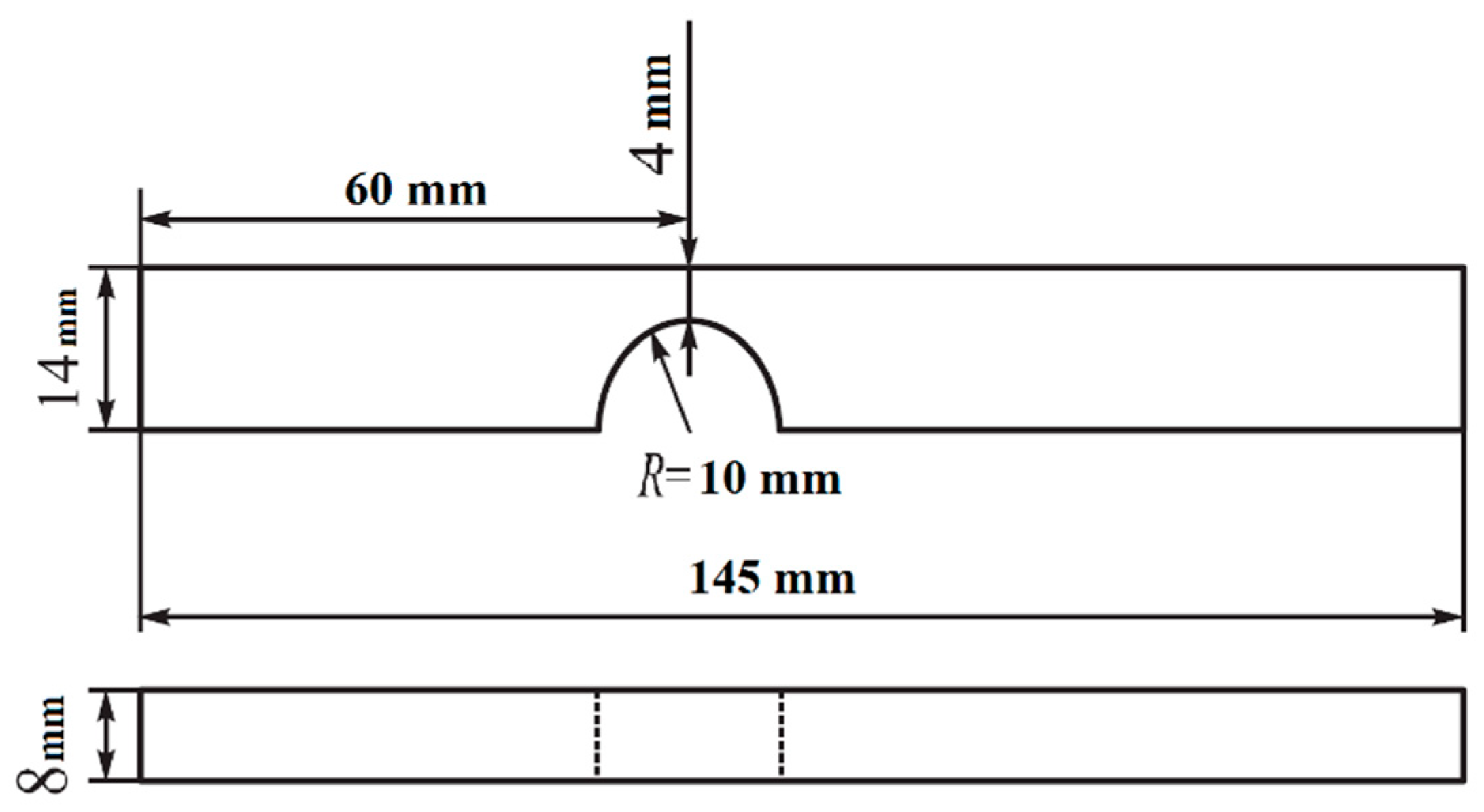
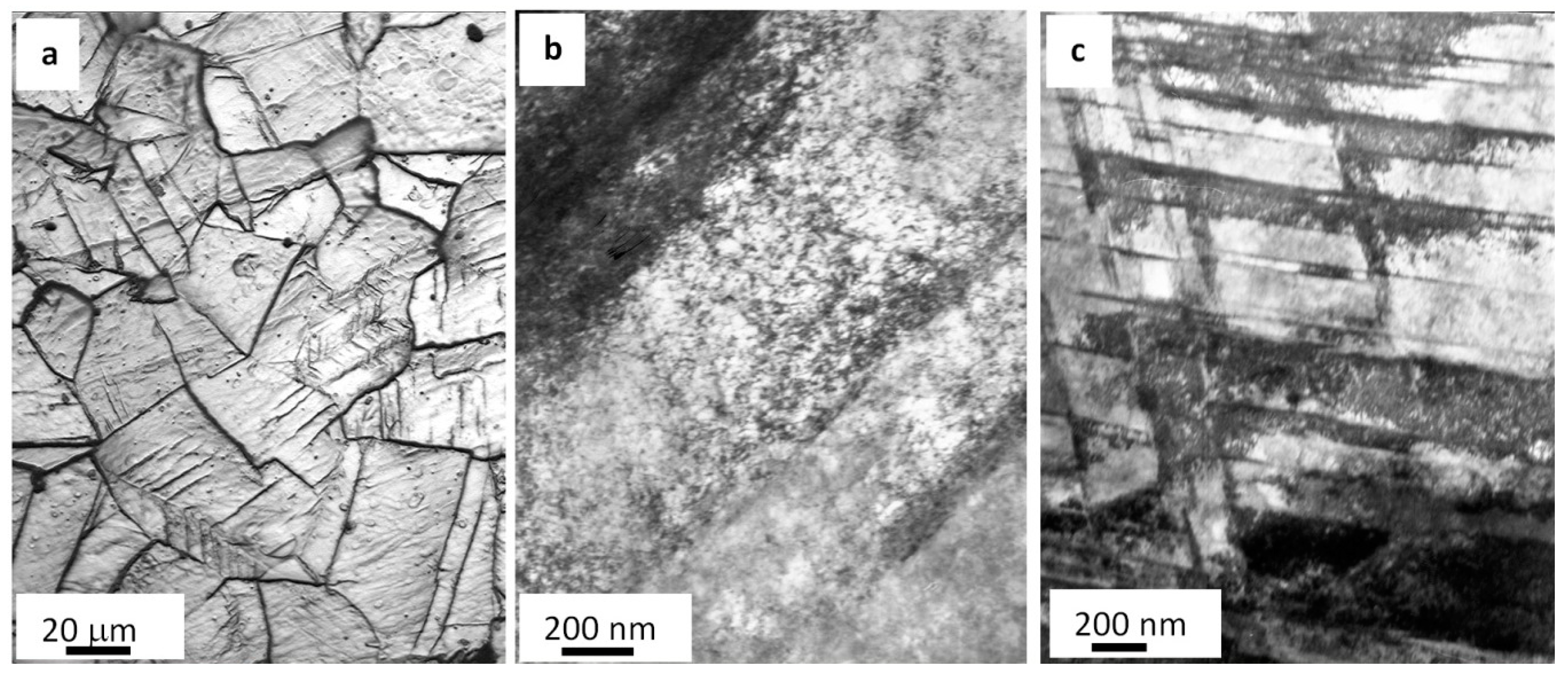


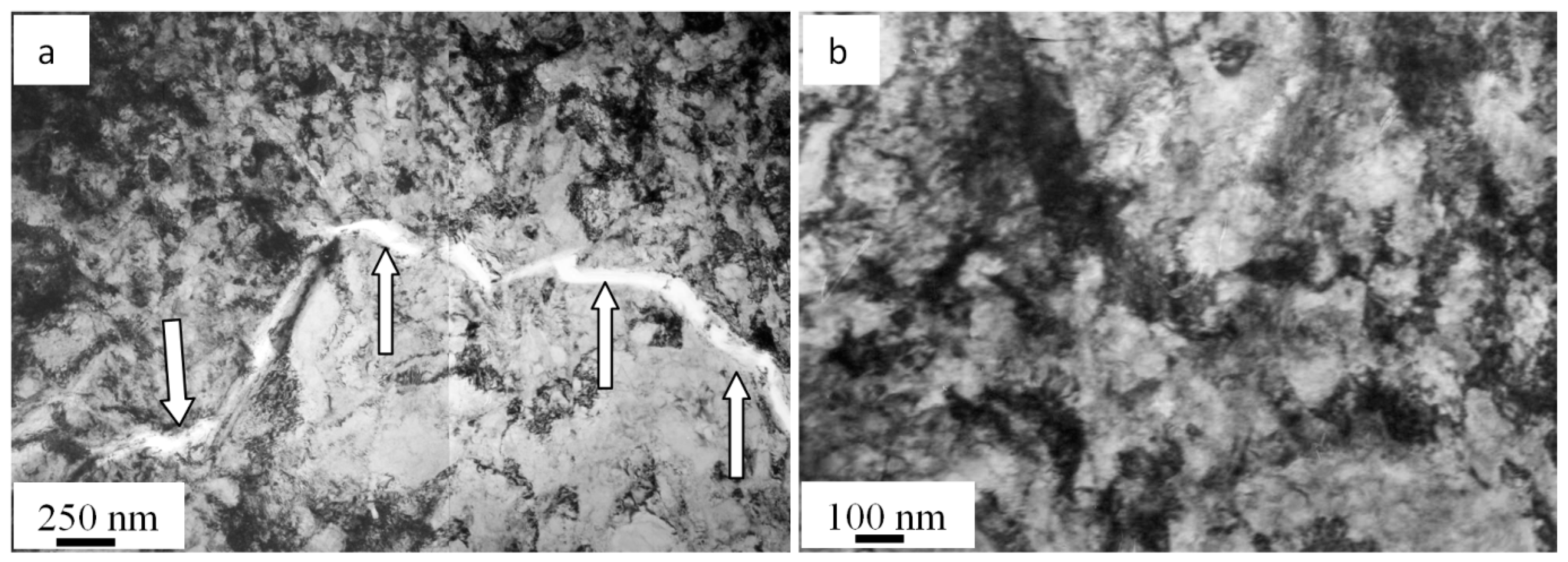


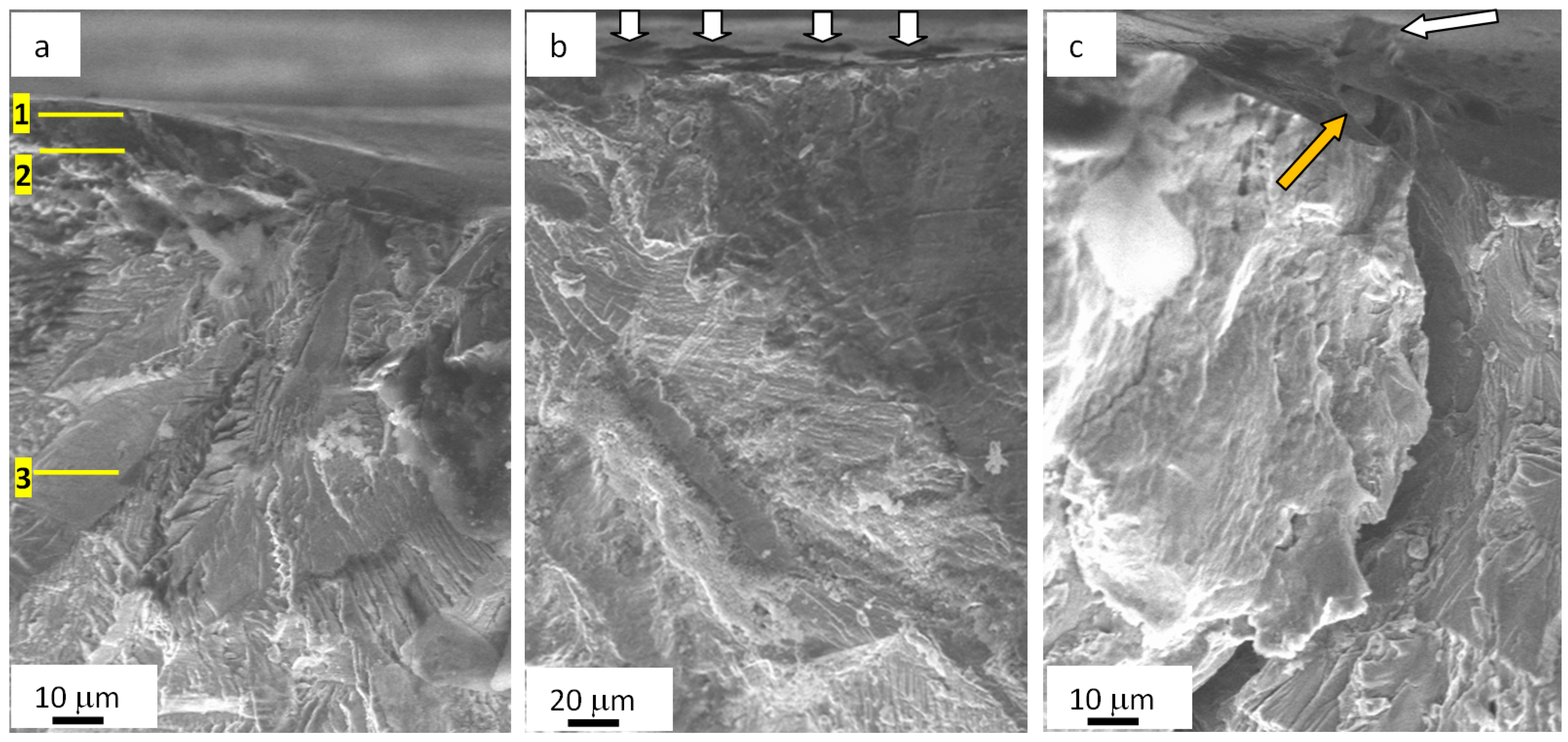
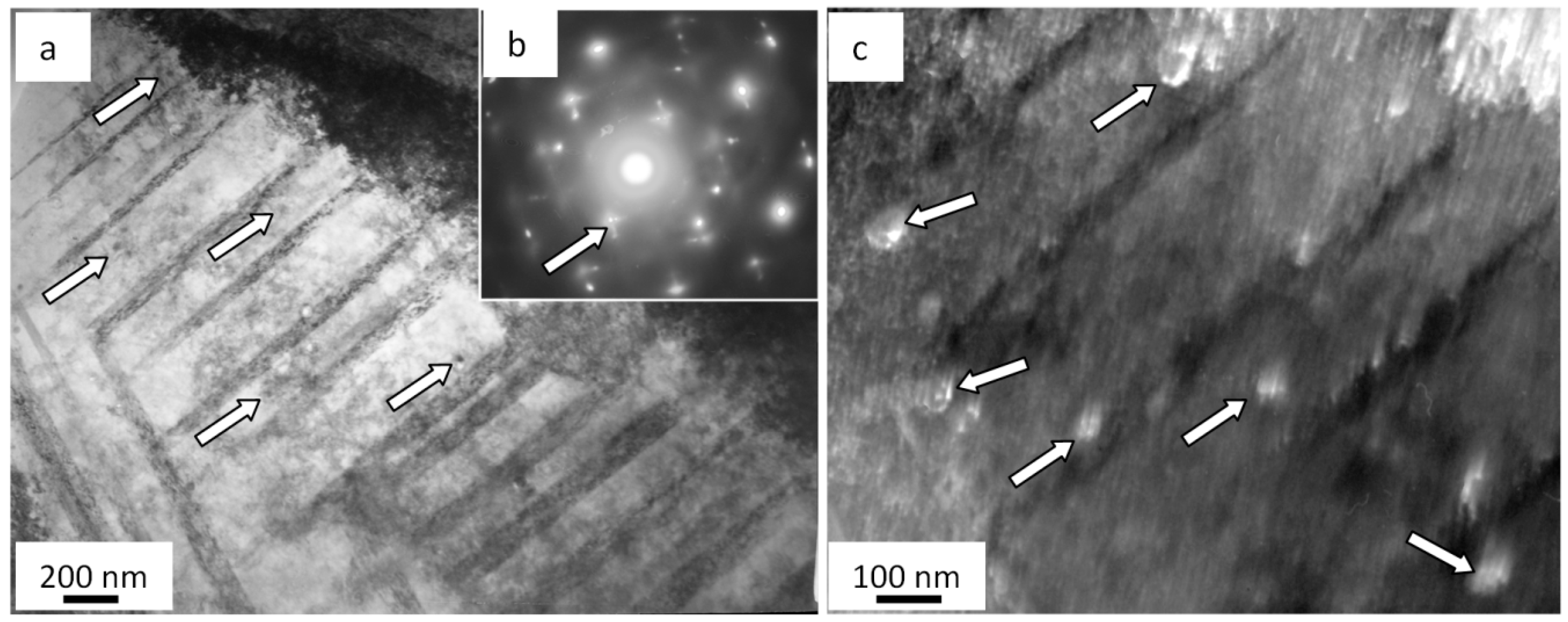
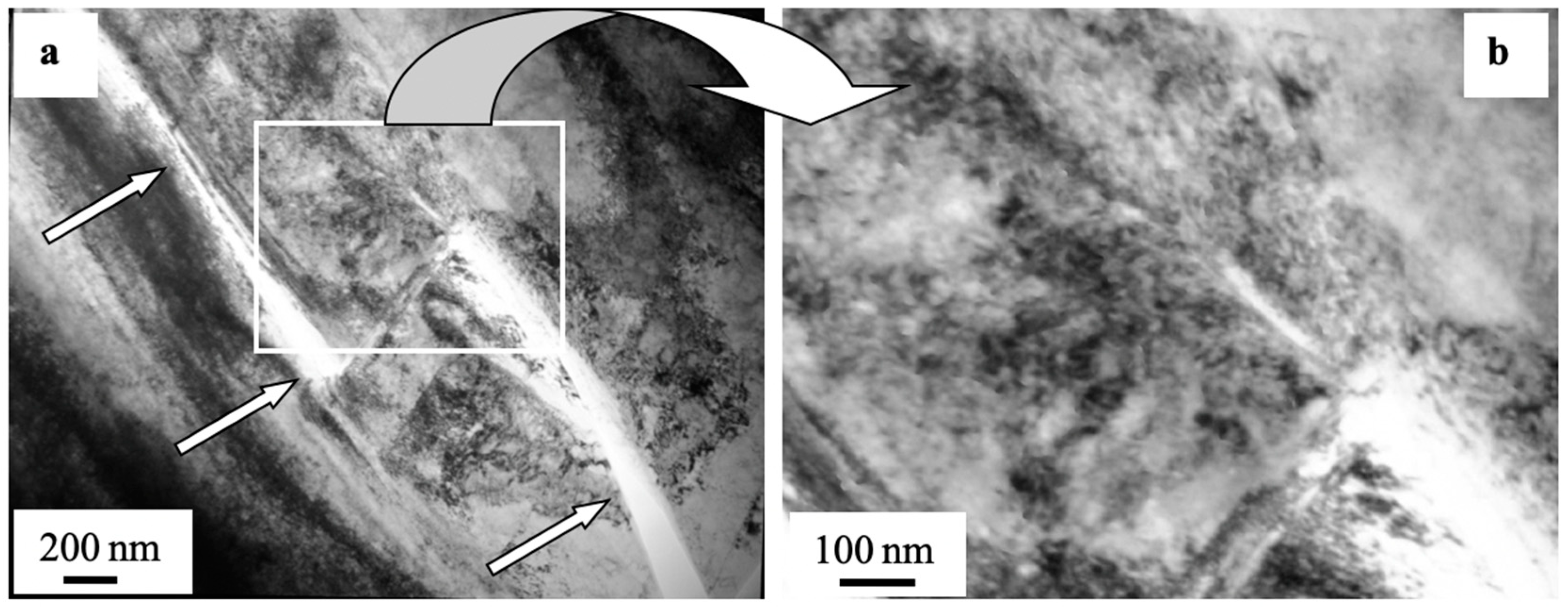
| >C | Ni | Cr | >Si | >Mn | >P |
|---|---|---|---|---|---|
| 0.2 | 17–20 | 22–25 | 1 | 0.02 | 0.035 |
| Without Electron Beam Irradiation | ES = 20 J/cm2; τ = 50 µs | ||
|---|---|---|---|
| No. of Sample | N, Cycles | No. of Sample | N, Cycles |
| 0101 | 143,432 | 2001 | 321,654 |
| 0102 | 161,313 | 2002 | 315,432 |
| 0103 | 150,124 | 2003 | 345,981 |
| 0104 | 153,985 | 2004 | 341,632 |
| 0105 | 165,409 | 2005 | 335,134 |
| 0106 | 143,107 | 2006 | 339,754 |
| 0107 | 151,184 | 2007 | 312,464 |
| 0108 | 149,643 | 2008 | 335,432 |
| 0109 | 151,210 | 2009 | 341,247 |
| 0110 | 154,210 | 2010 | 330,618 |
| Average value | 152,362 | Average value | 331,935 |
Publisher’s Note: MDPI stays neutral with regard to jurisdictional claims in published maps and institutional affiliations. |
© 2020 by the authors. Licensee MDPI, Basel, Switzerland. This article is an open access article distributed under the terms and conditions of the Creative Commons Attribution (CC BY) license (http://creativecommons.org/licenses/by/4.0/).
Share and Cite
Konovalov, S.; Ivanov, Y.; Gromov, V.; Panchenko, I. Fatigue-Induced Evolution of AISI 310S Steel Microstructure after Electron Beam Treatment. Materials 2020, 13, 4567. https://doi.org/10.3390/ma13204567
Konovalov S, Ivanov Y, Gromov V, Panchenko I. Fatigue-Induced Evolution of AISI 310S Steel Microstructure after Electron Beam Treatment. Materials. 2020; 13(20):4567. https://doi.org/10.3390/ma13204567
Chicago/Turabian StyleKonovalov, Sergey, Yurii Ivanov, Victor Gromov, and Irina Panchenko. 2020. "Fatigue-Induced Evolution of AISI 310S Steel Microstructure after Electron Beam Treatment" Materials 13, no. 20: 4567. https://doi.org/10.3390/ma13204567






